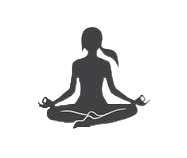General Guidelines
Listed below are various general guidance suggestions. You may wish to scan over these to see what resonates with you.
- Eat at least 2 hours before the asana session. It is difficult to perform asanas with a full stomach. Also, do not eat or drink half an hour after the session.
- The best time is early morning, after meditation.
- Find a cool and ventilated, quiet place with an even, level floor. The best place is a space reserved for Yoga and meditation.
- Perform gentle warm ups/limbering, a sequenced flow, cooldown and relaxation.
- Try to hold each posture for at least one minute to three minutes. It is said that holding for three minutes is the minimum time required to get all the benefits of the postures.
- Breathe consciously during the performance of postures. When holding a posture, the breath becomes calm and the mind focused.
- When holding a posture, know where to concentrate for the specific posture.
- If there is tension, focus your attention on the tension, breathe consciously while focusing on the area, sending prana to the muscles or ligaments, and during every exhalation try to progress a little more
by softening into the exhalation.
- Yoga is not a competition, so try to do what you can but observe your limit. Always try to feel comfortable. Never push yourself to the point of exhaustion.
- Be aware of your body throughout the session. Keep your mind focused inward and enjoy the practice. Never push your body into tension or pain. Honour your body with kindness, love and compassion, and reap the rewards
- Always relax inbetween the postures, with deep breathing to restore the prana and avoid fatigue.
- If there is no time, stick to the basic 3 or 4 postures without variations, or gently move through all the joint stimulating the synovial fluid in the joints. Bringing awareness to the body will slow down the breath and calm the mind.
You will get the maximum benefit.
- Take the time to practice headstand by preparing your arm strength with Dolphin, lifting the shoulders away from the ears to make space around the neck.
- Keep the spine flexible with forward and backward bends, spinal twists and sides bends.
- Keep the mind inpsired by being aware of the physical and mental benefits of each posture
- Achieve balance through posture and counter posture, on both the right and left sides, holding the postures on each side for an equal length of time.
- If you do variations, make sure that you have time for the basic postures first. Do not skip postures.
- It is better to practice in silence without music or chanting.
- It is better to practice asanas with eyes closed, creating an inner focus.
- Do not compare or compete with each other when performing in a group.
- Group performance of asanas brings about awareness of collective energy.
- It is better to perform the asanas without any props. It is a very natural way of exercising. However, blocks, blankets, bolsters and belts invite a more softer restorative approach to the practice.
- Use light and loose fit cotton clothing for better efficiency.
- Use a sticky Yoga mat for better performance.
- Always spend at least 10 minutes in Savasana at the end; this is the cream of the session.
- To maximize the benefit of the session, keep the energy internalized and calm and do not rush right away into worldly activities.
- Do not take a bath right away but allow the prana to remain for some time.
- Practice daily, or at least 4 times a week, for 1-2 hours for maximum benefit but if you can't manage this, then even short sessions of moving the joints is beneficial.
Om Shanti | Peace

